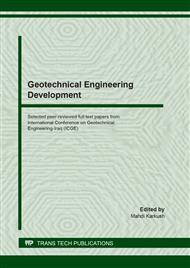p.56
p.66
p.74
p.83
p.89
p.99
p.109
p.120
p.130
Effect of Bedding Compaction on the Behavior of Buried Plain Concrete Pipes
Abstract:
Plain Concrete pipes serve as effective underground infrastructure lines especially as sewer lines and culverts. The installation quality has a high effect on the performance of the buried pipe-soil system besides the pipe material strength. In this research, experimental investigation of buried plain concrete pipes installed in gravelly-sand soil and subjected to strip loading platform as surface loading to search the effect of the bedding compaction on the pipe. Granular soil bedding is a traditional material surrounding concrete pipes. An experimental testing program for two precast plain concrete pipes has 300 mm inner diameter was conducted in a laboratory soil box test facility. Loading on a pipes-soil system were applied up to collapse. Circumferential strain in pipes was measured by means of strain gauges in addition to the measurements of displacement developed in the vertical direction by means of a linear variable differential transformer (LVDT’s) and dials gauges. It is concluded that in case of loose bedding, a higher bedding factor of 1.83 is produced in comparison with dense bedding which produces a bedding factor of 1.49, thus yields that the quality of installation is improved with relatively loose bedding under the pipe.
Info:
Periodical:
Pages:
89-98
Citation:
Online since:
August 2020
Authors:
Keywords:
Price:
Сopyright:
© 2020 Trans Tech Publications Ltd. All Rights Reserved
Share:
Citation:


